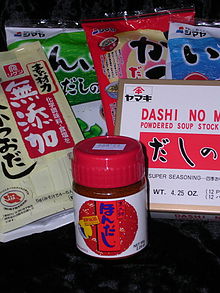Dashi
 Katsuobushishavings before being soaked in water | |
| Type | Stock |
|---|---|
| Place of origin | Japan |
| Variations | Kombu, shiitake, niboshi |

Dashi(RaNước,だし)is a family ofstocksused inJapanese cuisine.Dashiforms the base formiso soup,clear broth soup, noodle broth soup, and many simmering liquids to accentuate the savory flavor known asumami.[1]Dashiis also mixed into the flour base of some grilled foods likeokonomiyakiandtakoyaki.
Preparation
[edit]The most common form ofdashiis a simple broth made by heating water containingkombu(ediblekelp) andkezurikatsuo(shavings ofkatsuobushi– preserved, fermentedskipjack tunaorbonito) to near-boiling, then straining the resultant liquid; dried anchovies or sardines may be substituted.[2]Katsuobushi is especially high insodium inosinateand kombu is especially high inglutamic acids;both combined create a synergy ofumami.[3]
Granulated or liquid instantdashilargely replaced the homemade product in the second half of the 20th century. Homemadedashiis less popular today, even in Japan. Compared to the taste of homemade dashi, instantdashitends to have a stronger, less subtle flavor, due to the use of chemical flavor enhancers—glutamatesandribonucleotides.[4]
Variations
[edit]Other kinds ofdashiare made by soaking kelp,niboshi,orshiitakein water for many hours or by heating them in near-boiling water and straining the resulting broth.
- Kombu dashiis made by soaking or gently simmering kelp in water; soaking is traditional and fit for making baby food while simmering is a more modern practice. Kombu dashi becomes bitter and unpalatable when boiled.
- Niboshi dashiis made by pinching off the heads and entrails of small driedsardines(to prevent bitterness) and soaking the rest in water. Sometimes the heads are used as not everyone finds them to be bitter, and the fish are occasionally toasted to evaporate any volatile unpleasant fishy odors.
- Shiitake dashiis made by soaking dried shiitake mushrooms in water. Dried shiitake is preferred over fresh due to a stronger presence of savory or umami flavors.
See also
[edit]References
[edit]- ^"Umami – The Delicious 5th Taste You Need to Master!".Molecular Recipes.24 March 2013.
- ^Kaneko, Amy.Let's Cook Japanese Food!: Everyday Recipes for Home Cooking.p. 15.
- ^Hosking, Richard (2000).At the Japanese Table.Images of Asia. New York: Oxford University Press. p. 43.ISBN978-0-195-90980-7.LCCN00058458.OCLC44579064.
- ^Ozeki, Erino (2008)."Fermented soybean products and Japanese standard taste".In Christine M., Du Bois (ed.).The world of soy.Food series. Urbana: University of Illinois Press. p.155.ISBN978-0-252-03341-4.LCCN2007046950.OCLC177019229.
Further reading
[edit]- Hosking, Richard (1995).A Dictionary of Japanese Food.Tuttle.ISBN0-8048-2042-2.
